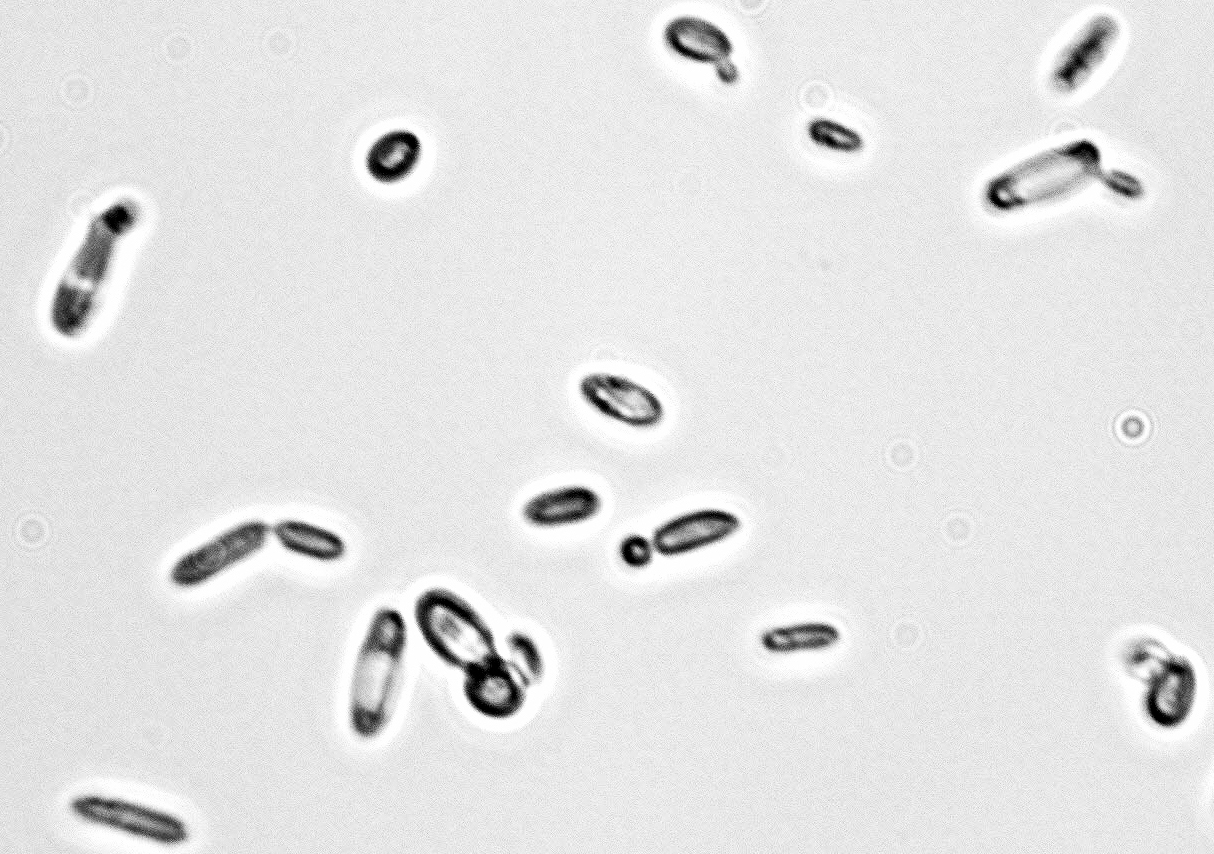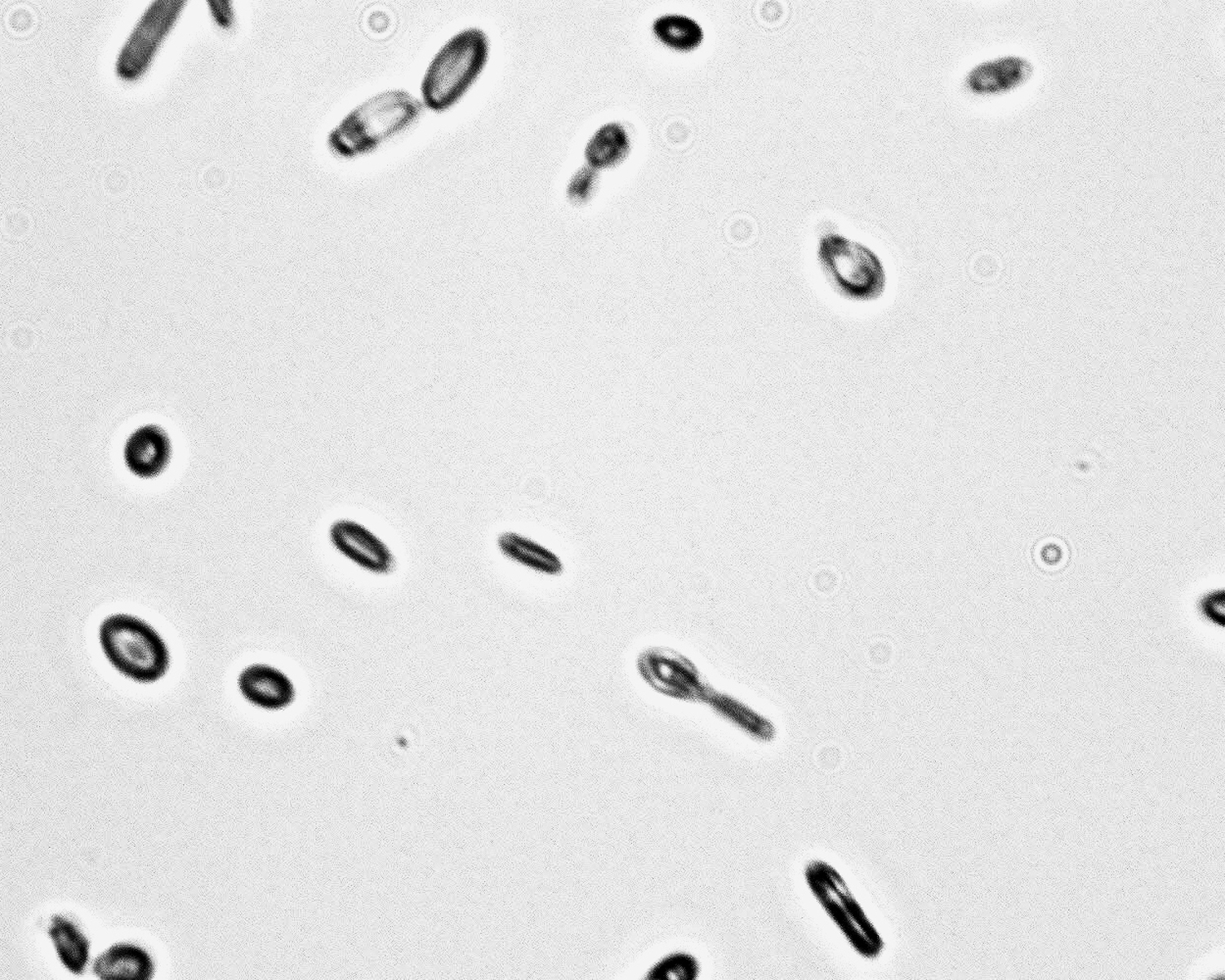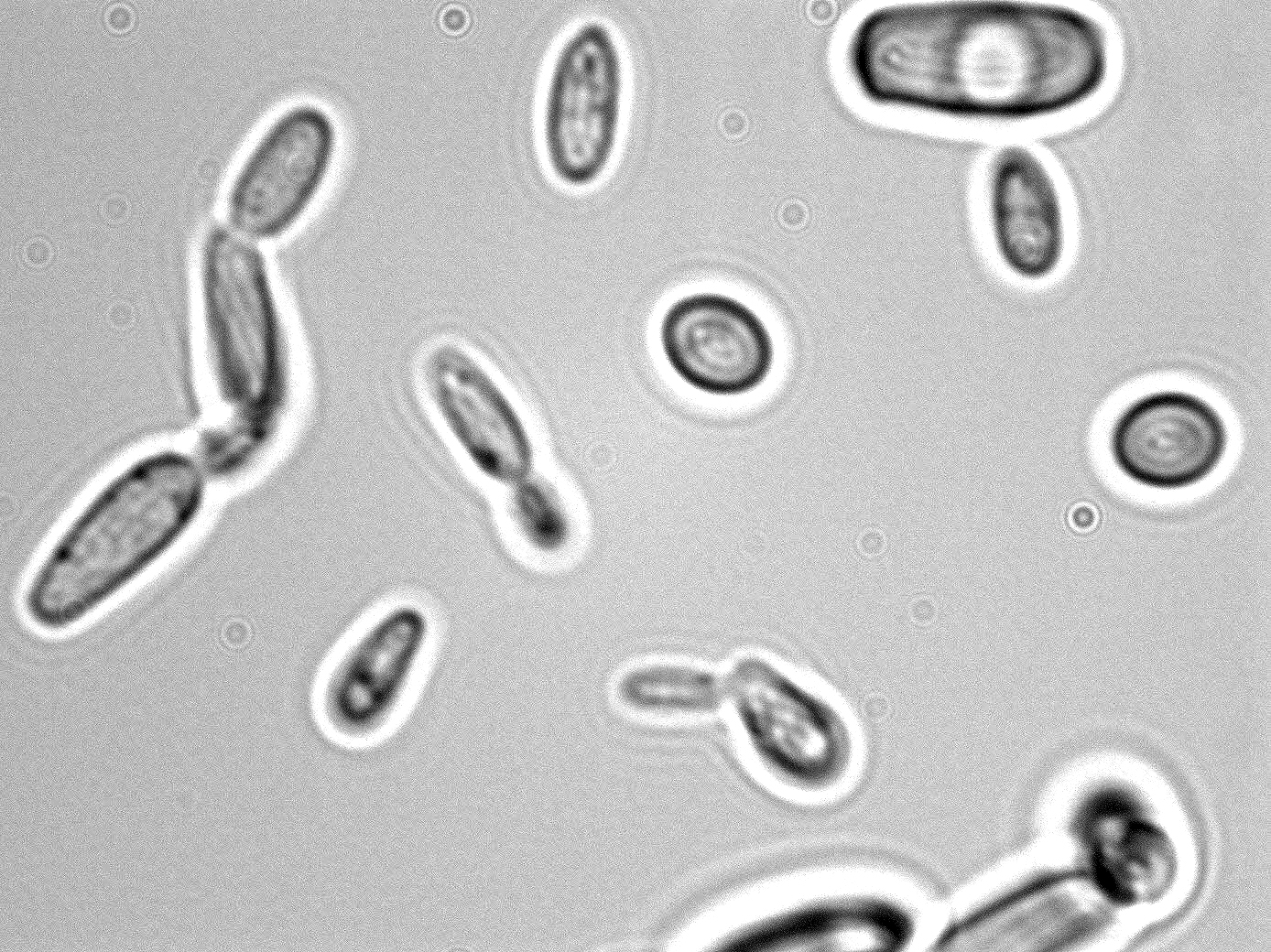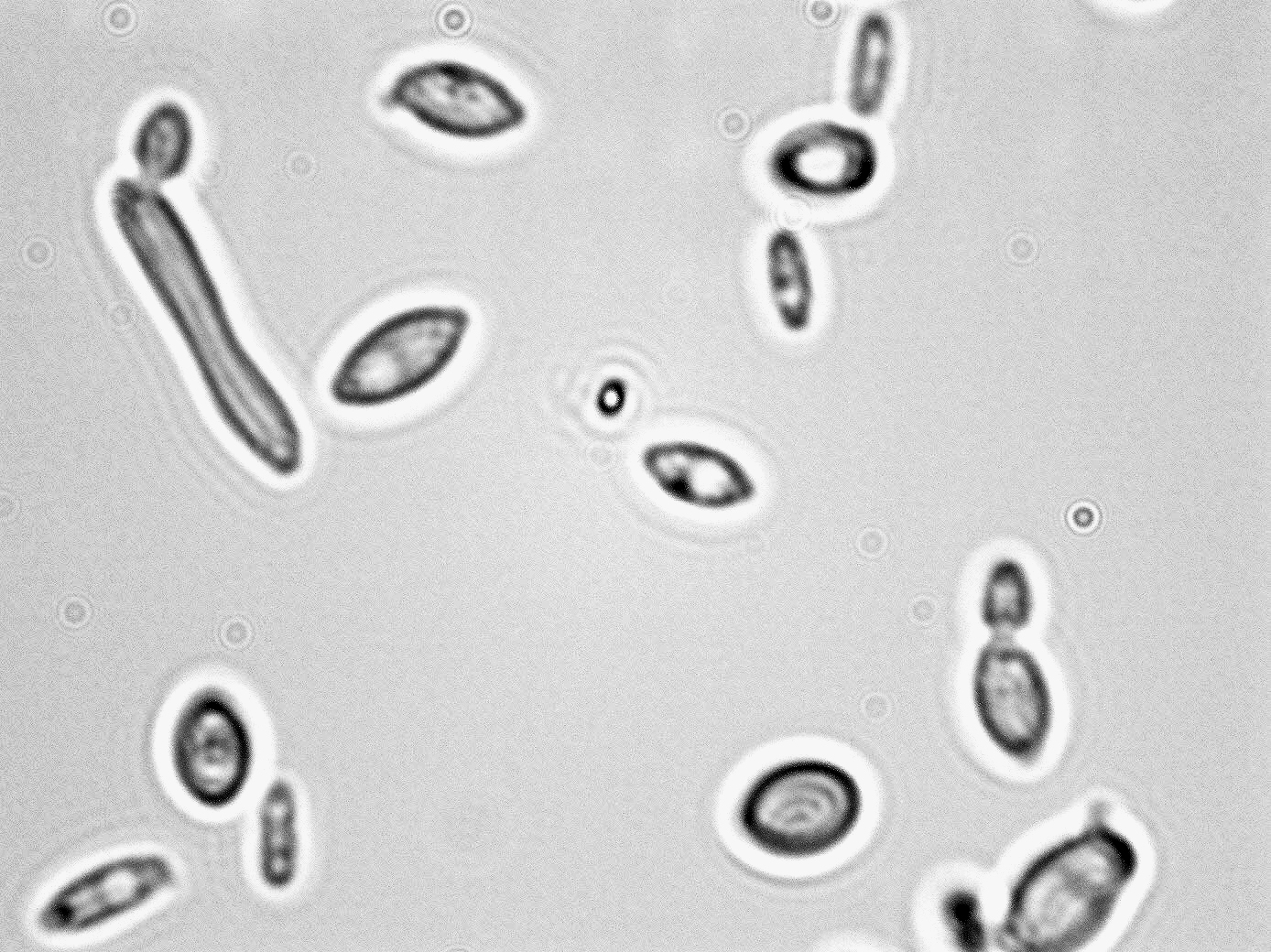Genus/Species: Dekkera bruxellensis (sporulating counterpart of Brettanomyces- i.e. Dekkera is the sporogenous form (ascospore-forming) or sexual teleomorph of Brettanomyces.)
Classification: Ascomycetes
Morphology:
 |
 |
 |
 |
Cell:
The vegetative cells are ogival in shape; which results due to repeated polar budding characteristics. In older cultures maintained in laboratories, populations appear elongated. Spherical, ellipsoidal and cylindrical cells have also been reported. Chains may also be observed and this is due to incomplete separation of the daughter cells. Cells vary in size.
Colony:
- Malt agar: Growth observed on malt agar. Cream colored, dull and rough looking colonies are observed.
- WL: Differential growth seen on WL, Saccharomyces does not grow but Dekkera does.
- Spore: The spore has a shape of a derby or bowler hat.
- Zygote: The species mainly reproduces by multipolar budding. Protrusion and growth of the bud is accompanied by annular wall thickening at the circumference of the intercell connection. Bud scars can be observed under the microscope.
- Ascus: Ascospores, if present, are hat shaped. Some strains show well formed pseudomycelium which are irregularly branched.
Liquid growth:
Pellicle formation(thin and appear as islands) and non-flocculent deposit is observed in liquid growth.
Ecological traits:
Most isolates of different strains have been obtained from wine samples, specially various dessert wine varieties. However, populations of the species have been found on grape surfaces (in the field) and from contaminated equipment in the winery as well as old oak barrels.
Physiological traits:
Like most yeasts, it can utilize a wide range of substrates for sugar requirements. Thus, glucose, fructose, arabinose and even trehalose, as well as alcohols (ethanol) and glycerol can be used as a carbon source. The growth of Brettanomyces/Dekkera in wine has been associated with various forms of spoilage including cloudiness and pellicle formation. Depending on the conditions and precursors available, these yeasts can produce acetic acid, contributing to wine's volatile acidity; tetrahydropyridines that are reminiscent of mouse-urine (mousiness); isovaleric acid, known for a rancid cheesy aroma and volatile phenols. 4-ethylphenol and 4-ethylguaiacol are the most important end products and help to characterize this organism. Production of volatile phenols is dependent on the strain and the corresponding environmental conditions. Strains can be classified as low, medium and high producers of volatile phenols.
Compound Character
4-EP (ethyl phenol) Band-aid, elastoplast
4-EG (ethyl guaiacol) Smoky, spicy, cloves
4-EC (ethyl catechol) Sweaty, horsey
Isovaleric acid Rancid, cheesy, vomit
Combination of all the above Horsey, barnyard, mouldy
Distinguishing features:
The presence of 4-ethyl phenol (a volatile phenol) is usually used as a measure of contamination by Brettanomyces andDekkera. This compound is used in particular, as its formation results only in the presence of two enzymes-cinnamate decarboxylase and vinylphenol reductase, both of which are only found in this species. Wines typically associated with a "Bretty character" are commonly recognised by aromatic defects ranging from medicinal smells (elastoplast, band-aid) to farmyard-like odours (horse sweat, wet animal, wet leather) and even spicy clove-like aromas.
Role in wine: Dekkera is usually observed during barrel aging. Contamination of wines by this organism result in the production of obnoxious odors and aromas. It is principally problem in red wines. The organism is capable of surviving in upto 10 to 11% alcohol and is fermentative. It is usually seen in wineries which use extensive barrel fermentation or where sanitation is neglected. It has been observed to spread across wineries through contaminated wine and equipment. Insects, specially fruit flies, are important vectors. It is usually difficult to control as its presence may go unnoticed till wine is permanently tainted. Several strategies have been applied to prevent the development of Dekkera during wine production. Among them there are improved hygiene, monitoring of nutrients and residual sugars during and at the end of fermentation, temperature control, use of sulphur dioxide, avoidance of old oak barrels, etc.
The presence of Dekkera in wine is harmful due to the formation of undesirable volatiles. Moreover, the microbe competes with the Saccharomyces for the nutrients in the must and thus limits or negatively impacts the fermentation characteristics as well. Contamination is a major issue and good winery sanitation and hygiene practices are the best preventive methods. Any contaminated equipment or wine must be quarantined and contact with any other wine or equipment must be avoided.
Sensitivities:
- SO2: 0.8ppm of sulfur dioxide has been reported to be effective in inhibiting growth of the species.
- Sorbate: Sorbic acid shows little inhibitory activity towards Dekkera, though it can inhibit Saccharomyces.
- DMDC: Concentrations of above 100mg/L (literature shows that 50-100mg/L is also effective) have been found to inactivate growth of the organism.
- pH: Tolerant to even low pH conditions, growth conditions show that it prefers acidic environments. pH values below 3.5 inhibit growth.
- Acids: Phenolic and hydroxycinnamic acids, specially ferulic acid have an inhibitory effect (very potent effect) on Dekkeraand this effect is amplified in the presence of ethanol.
- Ethanol: The organism is fermentative and can tolerate ethanol levels of upto 10-13%.
- Anaerobiosis: Able to survive.
- Heat: Thermal inactivation is usually observed at temperatures over 50°C. Heat sensitivity of the organism increases in the presence of ethanol (i.e. under wine conditions). Low temperatures (10-15°C) are found to inhibit growth.
- Pressure: Increased pressures are usually effective in inhibiting yeast activity, however, Dekkera has been found to grow in sparkling wines and carbonated beverages. Thus, the organism is quite resistant to increased pressures as well.
References:
Brettanomyces/Dekkera Selective media:
The media contains Bactoglycerol (2.4mL), wort agar (48.3g), actidione or cyclohexamide (50 mg) and deionized water (600mL). Saccharomyces is inhibited due to presence of actidione or cyclohexamide, allowing only growth of Dekkera.
